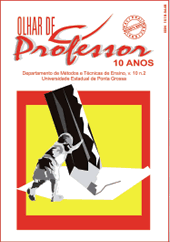IMPLICAÇÕES TEÓRICO-PRÁTICAS DO BINÔMIO CUIDAR-EDUCAR NA FORMAÇÃO DE PROFESSORES DE EDUCAÇÃO INFANTIL
Main Article Content
Abstract
entre cuidar-educar na Educação Infantil e na formação
de seus professores. Partimos de uma revisão histórica
sobre a origem e desenvolvimento das instituições de
Educação Infantil no Brasil, as formas de atenção voltadas
à criança e as mudanças nas concepções de infância
e Educação Infantil, para apresentar os elementos que
nos ajudam a compreender como foi sendo construído
o binômio cuidar-educar. Com base em tal revisão e
em entrevistas semi-estruturadas com formadores de
profissionais de educação infantil, o problema da separação
entre cuidado e educação foi analisado, com
vistas a desvendar sua origem e conseqüências para a
área. Ao final, usando a concepção histórico-crítica de
educação e a abordagem histórico-cultural de desenvolvimento
humano como referenciais teóricos de análise,
ressaltamos suas implicações para a Educação Infantil e
para a formação de professores que atuam (ou atuarão)
nessa modalidade de ensino, apontando alternativas de
enfrentamento do problema.
Downloads
Article Details
Authors who publish in this journal agree with the following terms:
a) Authors keep the copyrights and concede the right of its first publication to the magazine. The work piece must be simultaneously licensed on the Creative Commons Attribution License which allows the paper sharing, and preserves both the author identity and the right of first publication to this magazine.
b) Authors are authorized to assume additional contracts separately, to not-exclusively distribution of the paper version published in this magazine (e.g.: publish in institutional repository or as a book chapter), with the author identity recognition and its first publication in this magazine.
c) Authors are permitted and stimulated to publish and distribute their papers online (e.g.: in institutional repository or on their personal webpage), considering it can generate productive alterations, as well as increase the impact and the quotations of the published paper.
d) This journal provides public access to all its content, as this allows a greater visibility and reach of published articles and reviews. For more information on this approach, visit the Public Knowledge Project, a project that developed this system to improve the academic and public quality of the research, distributing OJS as well as other software to support the publication system of public access to academic sources.
e) The names and e-mail addresses on this site will be used exclusively for the purposes of the journal and are not available for other purposes.

This work is licensed under a Creative Commons Attribution 4.0 International License.

